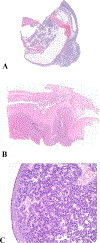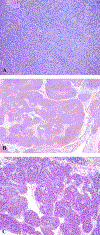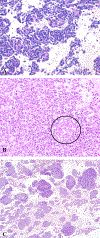A Distinctive Adnexal (Usually Paratubal) Neoplasm Often Associated With Peutz-Jeghers Syndrome and Characterized by STK11 Alterations (STK11 Adnexal Tumor): A Report of 22 Cases
- PMID: 33534223
- PMCID: PMC8277663
- DOI: 10.1097/PAS.0000000000001677
A Distinctive Adnexal (Usually Paratubal) Neoplasm Often Associated With Peutz-Jeghers Syndrome and Characterized by STK11 Alterations (STK11 Adnexal Tumor): A Report of 22 Cases
Abstract
We describe 22 examples of a novel, usually paratubal, adnexal tumor associated with Peutz-Jeghers syndrome in nearly 50% of cases that harbored STK11 alterations in all tested (n=21). The patients ranged from 17 to 66 years (median=39 y) and the tumors from 4.5 to 25.5 cm (median=11 cm). Most (n=18) were paratubal, with metastases noted in 11/22 (50%) and recurrences in 12/15 (80%). Morphologically, they were characterized by interanastomosing cords and trabeculae of predominantly epithelioid cells, set in a variably prominent myxoid to focally edematous stroma, that often merged to form tubular, cystic, cribriform, and microacinar formations, reminiscent of salivary gland-type tumors. The tumor cells were uniformly atypical, often with prominent nucleoli and a variable mitotic index (median=9/10 HPFs). The tumors were usually positive to a variable extent for epithelial (CAM5.2, AE1/AE3, cytokeratin 7), sex cord (calretinin, inhibin, WT1), and mesothelial (calretinin, D2-40) markers, as well as hormone receptors. PAX8, SF1, and GATA-3 were rarely positive, while claudin-4, FOXL2, and TTF-1 were consistently negative. All sequenced tumors (n=21) harbored alterations in STK11, often with a loss of heterozygosity event. There were no other recurrently mutated genes. Recurrent copy number alterations included loss of 1p and 11q, and gain of 1q, 15q, and 15p. Despite an extensive morphologic, immunohistochemical, and molecular evaluation, we are unable to determine with certainty the histogenesis of this unique tumor. Wolffian, sex cord stromal, epithelial, and mesothelial origins were considered. We propose the term STK11 adnexal tumor to describe this novel entity and emphasize the importance of genetic counseling in these patients as a significant number of neoplasms occur in association with Peutz-Jeghers syndrome.
Copyright © 2021 Wolters Kluwer Health, Inc. All rights reserved.
Conflict of interest statement
Conflicts of Interest and Source of Funding: B.W. was funded in part by Breast Cancer Research Foundation, Cycle for Survival and Stand Up To Cancer grants. Research reported in this publication was supported in part by a Cancer Center Support Grant of the NIH/NCI (Grant No. P30CA008748; MSKCC). The authors have disclosed that they have no significant relationships with, or financial interest in, any commercial companies pertaining to this article.
Figures










References
-
- Scully RE. Sex cord tumor with annular tubules a distinctive ovarian tumor of the Peutz-Jeghers syndrome. Cancer. 1970;25:1107–1121. - PubMed
-
- Solh HM, Azoury RS, Najjar SS. Peutz-Jeghers syndrome associated with precocious puberty. J Pediatr. 1983;103:593–595. - PubMed
-
- Young RH, Dickersin GR, Scully RE. Juvenile granulosa cell tumor of the ovary. A clinicopathological analysis of 125 cases. Am J Surg Pathol. 1984;8:575–596. - PubMed
-
- Slade I, Bacchelli C, Davies H, et al. DICER1 syndrome: clarifying the diagnosis, clinical features and management implications of a pleiotropic tumour predisposition syndrome. J Med Genet. 2011;48:273–278. - PubMed
-
- Simpson JL, Michael H, Roth LM. Unclassified sex cord-stromal tumors of the ovary: a report of eight cases. Arch Pathol Lab Med. 1998;122:52–55. - PubMed
Publication types
MeSH terms
Substances
Grants and funding
LinkOut - more resources
Full Text Sources
Other Literature Sources
Medical
Research Materials
Miscellaneous

